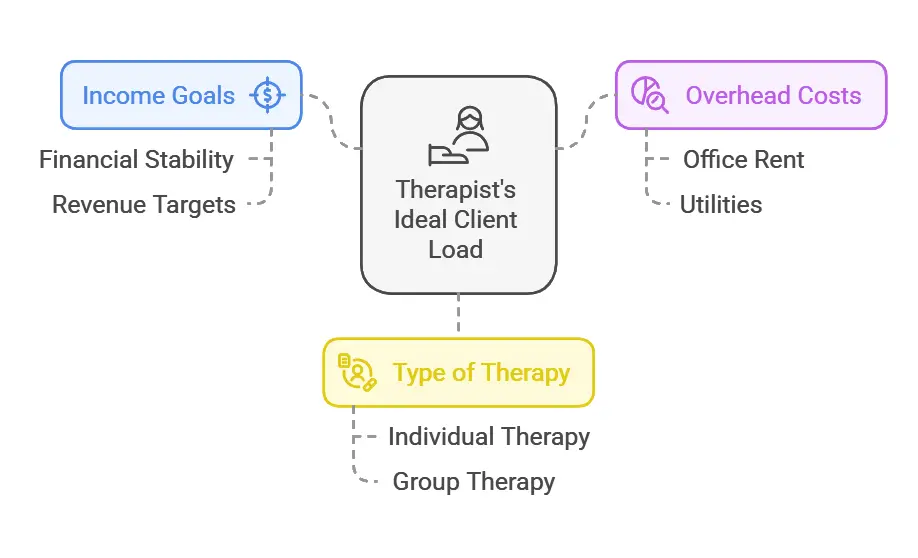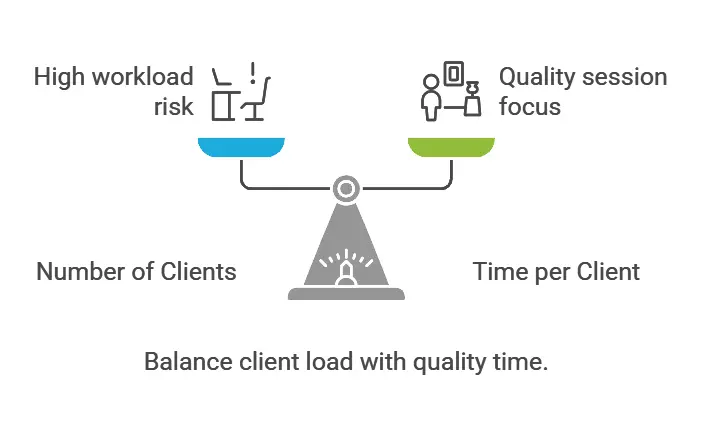This is a question that many therapists struggle with. On the one hand, you want to make sure that you can provide the best possible service to your clients. You don’t want to over-extend yourself and end up with too many clients.
In this blog post, we will discuss the ideal number of therapy clients and how to determine if you have reached that point. When it comes to the number of therapy clients, there is no one-size-fits-all answer. Every therapist has a different capacity, and each client brings unique needs and challenges to the therapeutic relationship.
How many clients does a therapist have?
If you’re a therapist, you’ve probably wondered how many therapy clients are too many. You may have even asked other therapists for their advice on this topic. It’s tough to determine the right number of clients, especially since each therapist’s practice is unique. However, there are a few things to consider when determining how many clients is the right amount for you.
For therapy, there is no one-size-fits-all answer to the question of how many clients a therapist should see. The number of clients you see should be based on several factors, including your income goals, overhead costs, and the type of therapy you practice.
Some therapists see 40 or 50 clients per week, while others only see a handful. The ideal number of clients for you will depend on your circumstances.
The importance of quality over quantity when it comes to therapy clients
It’s important to remember that quality is more important than quantity when it comes to therapy clients. It’s better to have a small number of clients who are engaged in treatment and making progress than a large number of clients who are not invested in the process. When you’re meeting with clients, make sure that you’re giving each one your full attention. This way, you can ensure that they’re getting the best possible care.
The amount of time you have for each client
Another factor to consider is the amount of time you have for each client. If you’re seeing a high number of clients, you may not be able to give each one the time they deserve. This can lead to feeling rushed during sessions and not being able to fully address each client’s needs. It’s important to find a balance between the number of clients you’re seeing and the amount of time you can spend with each one.

The type of clients you’re seeing
The type of clients you’re seeing can also affect how many is too many. If you’re working with clients who have complex needs, you may need to limit the number of clients you’re seeing. This way, you can ensure that you’re giving each client the attention they need. On the other hand, if you’re working with relatively low-maintenance clients, you may be able to see a higher number of them.
Your caseload capacity
Ultimately, the number of clients you’re seeing should be based on your own caseload capacity. This includes factors like how much time you have to dedicate to each client, how well you’re able to juggle multiple clients at once, and whether you’re comfortable with a higher or lower number of clients.
Your practice goals
The number of clients you’re seeing should also be in line with your practice goals. For example, if your goal is to provide long-term therapy to a small number of clients, you’ll need to limit the number of clients you’re taking on. On the other hand, if your goal is to provide shorter-term therapy to a larger number of clients, you may be able to see more clients.
Your financial goals
Of course, your therapy practice also needs to be financially sustainable. This means that you need to consider how many clients you need to see in order to cover your expenses and make a profit. If you’re not sure where to start, you can consult with a financial advisor or accountant who can help you figure out what your ideal number of clients should be.
The type of clients you want to work with
Last but not least, the number of clients you want to work with should be based on the type of clients you want to work with. For example, if you only want to work with a certain type of client (such as those with anxiety disorders), you’ll need to make sure that you’re seeing enough of those types of clients to make your business viable.
On the other hand, if you’re open to working with any type of client, you’ll have a bit more flexibility in terms of how many clients you see. Ultimately, it’s up to you to decide what type of practice you want to have and how many clients you’re willing to work with.

Tips for therapists who are struggling with client overload
When deciding how many therapy clients to see, there are a few things to consider.
- First, think about the type of therapy you practice. If you specialize in a certain population or type of therapy, see fewer clients so that you can provide quality care.
- Second, consider your schedule and how much time you have to devote to each client. If you’re only seeing clients for a few hours each week, you may want to see fewer clients so that you can spend more time with each one.
- Finally, think about your own energy level and capacity. Some therapists can handle a large caseload while others may find that they need more time between sessions to recharge.
If you’re not sure how many clients you can comfortably see, start by seeing a few clients per week and gradually increase your caseload as needed. Pay attention to how you feel after each session and take breaks as needed. You may also want to talk to other therapists to get their perspectives on how many clients is too many.

The Bottom Line
There’s no one-size-fits-all answer to the question of how many clients a therapist has. The number of clients you see should be based on several factors, including your income goals, overhead costs, and the type of clients you want to work with. Ultimately, it’s up to you to decide what’s best for your practice. If you’re just starting in private practice, it’s important to build up a solid client base. Once you have a few regular clients, you can start to focus on quality over quantity. Remember, it’s better to have a few loyal clients than a bunch of one-time appointments.
